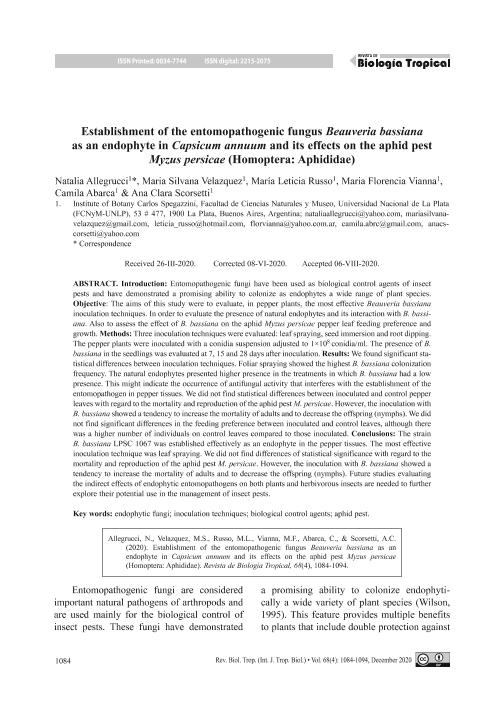Mostrar el registro sencillo del ítem
dc.contributor.author
Allegrucci, Natalia

dc.contributor.author
Velázquez, María Silvana

dc.contributor.author
Russo, Maria Leticia

dc.contributor.author
Vianna, María Florencia

dc.contributor.author
Abarca, Camila Lucía

dc.contributor.author
Scorsetti, Ana Clara

dc.date.available
2021-09-07T15:14:32Z
dc.date.issued
2020-12
dc.identifier.citation
Allegrucci, Natalia; Velázquez, María Silvana; Russo, Maria Leticia; Vianna, María Florencia; Abarca, Camila Lucía; et al.; Establishment of the entomopathogenic fungus Beauveria bassiana as an endophyte in Capsicum annuum and its effects on the aphid pest Myzus persicae (Homoptera: Aphididae); Universidad de Costa Rica; Revista de Biología Tropical; 68; 4; 12-2020; 1084-1094
dc.identifier.issn
0034-7744
dc.identifier.uri
http://hdl.handle.net/11336/139809
dc.description.abstract
Introduction: Entomopathogenic fungi have been used as biological control agents of insectpests and have demonstrated a promising ability to colonize as endophytes a wide range of plant species.Objective: The aims of this study were to evaluate, in pepper plants, the most effective Beauveria bassianainoculation techniques. In order to evaluate the presence of natural endophytes and its interaction with B. bassi-ana. Also to assess the effect of B. bassiana on the aphid Myzus persicae pepper leaf feeding preference andgrowth. Methods: Three inoculation techniques were evaluated: leaf spraying, seed immersion and root dipping.The pepper plants were inoculated with a conidia suspension adjusted to 1×108 conidia/ml. The presence of B.bassiana in the seedlings was evaluated at 7, 15 and 28 days after inoculation. Results: We found significant sta-tistical differences between inoculation techniques. Foliar spraying showed the highest B. bassiana colonizationfrequency. The natural endophytes presented higher presence in the treatments in which B. bassiana had a lowpresence. This might indicate the occurrence of antifungal activity that interferes with the establishment of theentomopathogen in pepper tissues. We did not find statistical differences between inoculated and control pepperleaves with regard to the mortality and reproduction of the aphid pest M. persicae. However, the inoculation withB. bassiana showed a tendency to increase the mortality of adults and to decrease the offspring (nymphs). We didnot find significant differences in the feeding preference between inoculated and control leaves, although therewas a higher number of individuals on control leaves compared to those inoculated. Conclusions: The strainB. bassiana LPSC 1067 was established effectively as an endophyte in the pepper tissues. The most effectiveinoculation technique was leaf spraying. We did not find differences of statistical significance with regard to themortality and reproduction of the aphid pest M. persicae. However, the inoculation with B. bassiana showed atendency to increase the mortality of adults and to decrease the offspring (nymphs). Future studies evaluatingthe indirect effects of endophytic entomopathogens on both plants and herbivorous insects are needed to furtherexplore their potential use in the management of insect pests.
dc.format
application/pdf
dc.language.iso
eng
dc.publisher
Universidad de Costa Rica
dc.rights
info:eu-repo/semantics/openAccess
dc.rights.uri
https://creativecommons.org/licenses/by/2.5/ar/
dc.subject
Endophytic Fungi
dc.subject
Inoculation techniques
dc.subject
Biological control agents
dc.subject
Aphid pest
dc.subject.classification
Micología

dc.subject.classification
Ciencias Biológicas

dc.subject.classification
CIENCIAS NATURALES Y EXACTAS

dc.title
Establishment of the entomopathogenic fungus Beauveria bassiana as an endophyte in Capsicum annuum and its effects on the aphid pest Myzus persicae (Homoptera: Aphididae)
dc.title
Establecimiento del hongo entomopatógeno Beauveria bassiana como endófito en Capsicum annuum y sus efectos sobre la plaga del áfido Myzus persicae (Homoptera: Aphididae)
dc.type
info:eu-repo/semantics/article
dc.type
info:ar-repo/semantics/artículo
dc.type
info:eu-repo/semantics/publishedVersion
dc.date.updated
2021-08-13T16:52:48Z
dc.journal.volume
68
dc.journal.number
4
dc.journal.pagination
1084-1094
dc.journal.pais
Costa Rica

dc.journal.ciudad
San José
dc.description.fil
Fil: Allegrucci, Natalia. Universidad Nacional de La Plata. Facultad de Ciencias Naturales y Museo. Instituto de Botánica Spegazzini; Argentina. Consejo Nacional de Investigaciones Científicas y Técnicas. Centro Científico Tecnológico Conicet - La Plata; Argentina
dc.description.fil
Fil: Velázquez, María Silvana. Universidad Nacional de La Plata. Facultad de Ciencias Naturales y Museo. Instituto de Botánica Spegazzini; Argentina. Consejo Nacional de Investigaciones Científicas y Técnicas. Centro Científico Tecnológico Conicet - La Plata; Argentina
dc.description.fil
Fil: Russo, Maria Leticia. Universidad Nacional de La Plata. Facultad de Ciencias Naturales y Museo. Instituto de Botánica Spegazzini; Argentina. Consejo Nacional de Investigaciones Científicas y Técnicas. Centro Científico Tecnológico Conicet - La Plata; Argentina
dc.description.fil
Fil: Vianna, María Florencia. Universidad Nacional de La Plata. Facultad de Ciencias Naturales y Museo. Instituto de Botánica Spegazzini; Argentina. Consejo Nacional de Investigaciones Científicas y Técnicas. Centro Científico Tecnológico Conicet - La Plata; Argentina
dc.description.fil
Fil: Abarca, Camila Lucía. Universidad Nacional de La Plata. Facultad de Ciencias Naturales y Museo. Instituto de Botánica Spegazzini; Argentina. Consejo Nacional de Investigaciones Científicas y Técnicas. Centro Científico Tecnológico Conicet - La Plata; Argentina
dc.description.fil
Fil: Scorsetti, Ana Clara. Universidad Nacional de La Plata. Facultad de Ciencias Naturales y Museo. Instituto de Botánica Spegazzini; Argentina. Consejo Nacional de Investigaciones Científicas y Técnicas. Centro Científico Tecnológico Conicet - La Plata; Argentina
dc.journal.title
Revista de Biología Tropical

dc.relation.alternativeid
info:eu-repo/semantics/altIdentifier/doi/https://doi.org/10.15517/RBT.V68I4.41218
dc.relation.alternativeid
info:eu-repo/semantics/altIdentifier/url/https://revistas.ucr.ac.cr/index.php/rbt/article/view/41218
Archivos asociados
